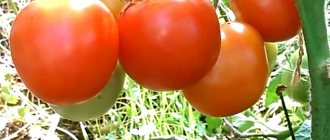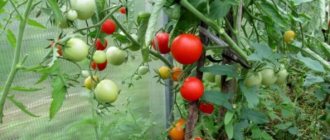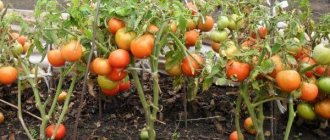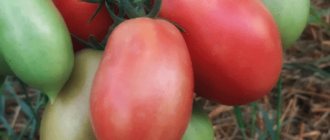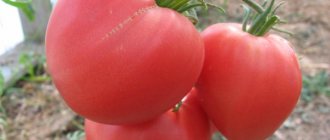“Tomato sandwich” sounds somehow unusual. But, believe me, with the right variety it is possible, and surprisingly tasty. Not long ago, a new designation “beef” appeared in the breeding terminology of tomatoes, which translated from English means “beef”. What does beef have to do with tomatoes? Apart from comparing the quality of the pulp, nothing. But this is the term used to refer to all fleshy tomato varieties. One of the brightest representatives of such varieties is Big Beef. An application for its registration in 2008 was submitted by Monsanto Holland BV. In the same year, the new product was included in the State Register of Breeding Achievements of Russia with admission to the Northern, Northwestern, Volga-Vyatka, Central, Middle Volga and North Caucasus regions, as well as the same for the Central Black Earth District. The tomato showed the best results when grown under film covers. The variety is recommended for personal plots. It is a hybrid, so it is always labeled F1.
Description of the tomato variety Big Beef F1
Big Beef F1 is a hybrid belonging to the salad category. In America this is one of the most popular varieties. Tomatoes are supplied to fast food chains for making hamburgers.
The culture is of an indeterminate type, medium-sized, the length of the stems rarely exceeds 1.8 m. In an open area, the height without correction is within 1.6 m. Shoot formation is intense. Up to two stepsons are formed in each leaf axil.
The internodes of the hybrid are long and the foliage is weak. The bush is formed with one central stem, less often with two. For strengthening, a developed lateral shoot of the first order is used.
Big Beef is an early ripening variety, the first fruits enter the phase of biological ripeness 110 days after emergence in greenhouse conditions
In an open area, ripening occurs 10 days later.
Characteristics of the Big Beef bush:
- The stem is green with a brown tint, with a rigid fiber structure, thick, the surface is uneven with sparse short hair.
- The leaves are arranged sparsely, alternately. The density of the green mass is due to the numerous formation of leaf blades on rather long petioles. Foliage with a corrugated surface, dark green, pubescent, with coarsely toothed edges.
- Fruit clusters are simple, the first ones are formed in the sixth leaf axil, the next ones are formed after 4 leaves. Density – 4–6 ovaries.
- Light yellow flowers are collected in bisexual inflorescences.
- The root system is superficial, compact, the trunk circle is no more than 35–40 cm.
Big Beef is a drought-resistant crop, but does not respond well to sudden changes in temperature, so full growing season is possible only in closed ground.
Fruit ripening is unfriendly, the period is extended for 3 months
Description of fruits
A representative of the Big Beef culture is classified as a large-fruited tomato. By removing part of the ovaries from one bunch, you can grow a tomato up to 800 g. Tomatoes do not ripen at the same time, their mass is not leveled, the higher the clusters are located, the smaller the fruits on them.
Characteristic:
- flat-round shape, smooth surface, slightly ribbed at the base;
- the weight of the first harvest is 300 g, the fruits of the middle clusters are 220 g, the top ones are 120–150 g;
- the peel is thin, bright red, prone to cracking if there is excess moisture;
- the pulp is juicy, fine-grained, without voids and white fibers, bright red, fleshy.
Important! When growing seedlings from seeds collected independently, Big Beef F1 does not retain the characteristics of the mother plant.
The variety has earned a high tasting rating. The taste of tomatoes is dominated by sweetness, and the acid is practically not felt. Balance depends on the method of cultivation: in an open area with a deficiency of ultraviolet radiation, acid predominates in the taste, and white fragments are visible in the pulp.
The fruits of the Big Beef variety are multi-chambered and have small seeds.
Sowing and growing seedlings
It is better to sow in early March. In order for the shoots to be friendly and fast, you need to organize moist, warm heating. For this:
- the seeds are wrapped in damp cloth;
- placed in a plastic bag;
- sent to a warm place (24-26 ᵒC);
- stand for 3-4 days.
Sowing is carried out only with sprouted seeds. Under such conditions, seedlings appear on the 5-6th day. In this case, cultivation will proceed at a faster pace.
Tomato seeds are sown in pre-prepared soil. It should be:
- loose;
- free from weeds;
- nutritious;
- slightly alkaline or neutral.
The industry has taken care of vegetable growers by producing excellent universal soils for seedlings. They are tested for phytopathogenicity and enriched with nutrients. Seedlings in such soil grow quickly.
Before emergence, the temperature should be within 25-26 ᵒC. After the sprouts appear, the greenhouse shelter is opened, the temperature is lowered by 3-4 degrees, but the illumination is increased. By choosing the brightest lighting for Big, you can prevent the seedlings from stretching.
When 2 true sheets appear, a dive is performed. This cannot be delayed. Intensive growth provokes severe overgrowth. Late picking leads to stress and stunted growth.
To plant plants proceed as follows:
- Prepare a container or disposable, individual cups.
- Fill them with the prepared earthen mixture.
- Compact.
- The lower part of the root of the tomato is separated and a cup is lowered into the soil.
- Press down the soil.
- Watered.
The plant quickly takes root and grows. To slow down the stretching, the temperature is lowered:
- at night - up to 16-17 ᵒC;
- during the day - up to 18-20 ᵒC.
Characteristics of Big Beef tomato
Tomatoes of this group are distinguished by simple agricultural technology, but long daylight hours are required for full fruiting. To increase the productivity of the Big Beef F1 hybrid, special lamps are installed. The taste of the tomato and the speed of its ripening depend on this condition.
Big Beef tomato yield and fruiting
The first wave of the harvest is harvested in July. The cycle continues until the end of September. The fall in temperature in autumn stops the growing season of tomatoes. Fruits picked in a state of milky ripeness do not ripen under artificial conditions, since the process of rotting begins.
Tomato productivity is high, regardless of whether the bush is formed with one or two stems. During the season, the crop produces 4–4.5 kg of fruit. Plant no more than 3 bushes per 1 m2. About 12 kg are collected from this area. In an open area, the level of tomato fruiting is 2–2.5 kg lower. The indicator depends on timely fertilizing, watering, duration of lighting, and soil aeration.
Important! In an unprotected garden bed, weather conditions affect the yield. During the season with prolonged rainfall, the number of tomatoes is much smaller.
Pest and disease control
The Big Beef hybrid is highly resistant to diseases, but if not properly cared for, it can still be affected by them. Viral diseases cannot be treated, and the bush is simply destroyed. Fungi can grow on tomatoes in high humidity conditions. Such lesions can be diagnosed by dark spots growing on the stem, fruits and leaves. Bordeaux mixture and other products containing copper will help cope with fungal infections.
Advice! If the greenhouse is regularly ventilated, the risk of disease is greatly reduced.
On tomatoes you can often find pests such as:
- mole cricket;
- aphid;
- gall midge;
- whitefly
The best way to control insects is with insecticides. For those who adhere to traditional methods, we can recommend infusions of onion peels, soda or ash.
Advantages and disadvantages of the variety
Big Beef F1 tolerates transportation well over long distances while maintaining a temperature of +6–10 °C. It is advisable to process tomatoes immediately, since they have a short shelf life.
When kept in the vegetable section of the refrigerator, Big Beef F1 fruits retain their nutritional value for no more than a week
pros
- good yield indicator;
- stable fruiting in greenhouse structures;
- standard agricultural technology;
- compactness of the root system and crown. The bush does not take up much space;
- early and long ripening of tomatoes;
- strong immunity.
Minuses
- short shelf life;
- the taste of tomatoes in an open area depends on weather conditions;
- the peel does not retain integrity during heat treatment;
- poor stress resistance.
Some gardeners note that the Big Beef variety has intensive shoot formation, so the tomato needs pinching.
Super early and early
Varieties and hybrids that produce crops early will be the best choice for planting in the garden. Their diversity is amazing, and it’s not so easy to find the right tomato that will please you with a good result. Super-determinant tomatoes yield their crops very quickly, and thanks to this they also “escape” late blight. We recommend the following ultra-early ripening tomatoes:
Aphrodite
A super early variety of tomatoes, the first fruits can be harvested after 80 days.
Designed for growing in open beds, productive (up to 8 kg per 1 square meter), very tasty tomato. The fruits are round, with smooth glossy skin, red, weighing up to 115 grams.
Plant height is 45-50 cm, tomatoes do not need pinching, but supports for gartering the clusters are needed.
Bullfinch
This is an early bird, as the fruits ripen within 95-97 days. This unpretentious and cold-resistant variety is very popular in Siberia and the North-West.
Its bushes are up to half a meter high, the fruits are bright red, round, slightly flattened. Weight is up to 170-200 grams, and the taste of the fruit is excellent.
Labrador
Another early variety is Labrador, which begins to bear fruit already at 95-98 days. Its fruits are very dense, look like red apples, weighing up to 150 grams.
Tomatoes are picked green; they “arrive” very well at home. Suitable for all types of processing, as well as for preservation and, of course, fresh consumption.
Early love
An unpretentious and unpretentious tomato produces fruits weighing up to 200 grams. Ripening time is 90 days, with minimal plant care required. Does not require pinching, is very resistant to natural disasters, productive (up to 5-6 kg of fruit per square meter).
Bush height – 80-100 cm.
Don Juan
If you want to grow unusual, ultra-early tomatoes, then it’s time to look at the Don Juan tomato.
Ripening time is only 95 days, the fruits are round and slightly elongated. Weight – up to 80 grams. The color of the fruit is original - crimson with golden veins and strokes. This tomato is considered one of the most delicious among the early varieties.
Golden stream
For lovers of colorful tomatoes, we recommend the Golden Stream tomato. The first fruits can be harvested after 95-100 days, making it a very suitable variety for growing in regions with a short summer season.
The bushes are 60 cm in height, the fruits are ellipsoidal, very dense, rich orange in color. Features of the variety: excellent keeping quality of tomatoes, versatility of use, suitability for transportation. The taste is high.
We really hope that our descriptions and recommendations on tomato varieties will be useful to you. And good harvests to you!
Natalia Severova
Features of growing the variety
Big Beef F1 is grown from previously obtained seedlings. Planting material is purchased from a retail chain. Tomato seeds do not need disinfection; they went through all the necessary procedures before packaging. Seeds for seedlings are planted in early March using the following technology:
- The containers are treated with hot water with the addition of manganese.
- The substrate is used ready-made or compost is mixed with peat and sand, and nitrogen-containing fertilizer is added.
- Before laying in containers, the soil is thermally treated.
- Tomato seeds are deepened by 1.5 cm, maintaining a distance of 2 cm. Cover with substrate and water.
- The container is covered with film or glass, left in this form until germination, the soil is periodically moistened and ventilated.
When shoots appear, remove the protective material and provide the seedlings with a temperature of +23–25 °C
After 10 days, fertilize the tomato with Agricola.
Picking is carried out in small separate containers after approximately 25 days, when 6 leaves have formed on the tomato. The temperature is reduced to +18–20 °C, the lighting is left the same or increased up to 24 hours. Water at the first signs of drying out of the soil.
Tomatoes are transplanted into the greenhouse in early May, to an open area, when the night temperature has settled at +10 °C and above. The seedlings are planted in furrows at an angle, covered with soil up to the first leaves. No more than 3 copies are placed per 1 m² of area. When planting in one line, the distance between the tomatoes is 30–40 cm; if there are several furrows, then the interval between them is 0.5 m. When the tomato grows to 30 cm, it is hilled up and the mound is covered with mulch.
Agricultural technology Big Beef F1:
- It is necessary to fix the shoot to the trellis. The garter is carried out as it grows.
- Removing the stepsons, lower leaves and brushes from which the crop was harvested.
- Watering is carried out once every 10 days.
- Loosening is done every week.
- To prevent the growth of weeds, mulch materials are used.
The crop is fed with potassium fertilizers at the beginning of flowering, and with phosphorus fertilizers during fruit formation. Phosphate is used during the ripening period of the crop. Fertilize with liquid organic matter no more than once every 14 days, the procedure is carried out until the end of August.
Planting in the ground and caring for tomatoes
When replanting, you should be careful about choosing a good place in the garden. If tomatoes, potatoes or peppers were already growing on the site last year, it is better to abandon such a place. Neighborhood with these crops is also undesirable. It is better to plant Big after peas or cucumbers.
Soils for planting should be:
- lungs;
- fertile;
- with slight alkalinity or neutral.
When planting seedlings, it is advisable to bury the shoots. This will give additional roots and increase the feeding area.
Particular attention is paid to stepchildren. They all need to be removed when they reach a length of 1.5-2 cm.
Forming Big into one or two shoots will allow you to get a good harvest, but subject to regular, deep watering. Only with water can the plant absorb nutrients. Watering is carried out 3-4 times a week, 2-3 liters for each bush.
No matter how fertile the soil is, Big Beef needs feeding. During the growing season they need to be carried out at least 3 times:
- 2-3 weeks after planting. To do this, it is enough to use organic matter - dilute 1 kg of pig or cattle manure in a bucket of water. If you use chicken manure, the concentration is reduced by 2 times (0.5 kg of manure per bucket of water);
- As soon as the tomatoes enter the budding stage, add a tablespoon of potassium sulfate to the organic solution;
- 15-20 days after the second feeding, the third is carried out. You don’t have to use organic matter anymore, but potassium will make the fruits extraordinarily tasty.
The formation of a bush is constantly being done. Since Big is indeterminate, garters and attachment to supports are the basis for high-quality fruiting. You should not allow the shoot to sink under the weight of the tomatoes, this can lead to a break.
It is best to harvest when the fruits begin to turn brown. In this case, the acetylene released during ripening will not interfere with the growth of subsequent tomatoes.
Description of the Rosebeef variety
The fruit has a pleasant taste
The Rosebeef variety is also a hybrid. In terms of taste and commercial qualities, its fruits are not inferior to other beefsteak varieties.
Main characteristics of the Rosebeef species:
- The bush is strong, reaches a height of 1.8 m.
- The leaves are green and grow densely.
- The ripening period is late, 100-120 days after planting.
- The yield is 8-11 kg per square meter of bed.
Hybrid Rosebeef is resistant to fusarium and vercillosis. The plant tolerates high temperatures and drought well. The fruits of the Rosebeef tomato are pink in color and have a pleasant taste. The commercial quality of the tomato is excellent. The average weight of one fruit is 250-300 g.
Description of the Pink variety
The beefsteak tomato Pink was bred agro. There is another popular variety of Pink Brandy. Both varieties belong to the first generation hybrids.
The varieties have the following general characteristics:
- The bush is compact, the leaves grow densely.
- The ripening period is mid-early. The fruits ripen unevenly.
- The yield is high - 25 kg per square meter of bed.
- High resistance to low temperatures and droughts.
- High resistance to bronze virus, fusarium, and vercillosis.
Based on reviews from gardeners, it can be judged that the plant takes root well in the middle zone. Yield indicators do not suffer. Pink is unpretentious in care.
Features of planting tomatoes
To obtain a normal harvest in a timely manner, planting dates and rules must be followed. First you need to select high-quality seeds (it is recommended to buy only from trusted suppliers and pay attention to expiration dates). It is important to ensure normal lighting, watering and fertilizing of plants after climbing.
Preparing seeds and soil
Soil for seedlings can be purchased ready-made or made yourself. For this you will need soil, sand and peat. Tomatoes (of any variety) love soft and porous soil, so sphagnum moss is sometimes used.
Basic soil requirements:
- it must be balanced and contain all the necessary minerals and trace elements for the full growth of seedlings;
- it should be porous and light, in no case clogged;
- to avoid parasites and weed seeds in the soil, it is better to use purchased soil rather than garden soil;
- a neutral acidity level is the key to quality seedlings and, in the future, harvest.
Expert opinion
Stanislav Pavlovich
Gardener with 17 years of experience and our expert
Ask a Question
For reference: sphagnum is moss that is added to make the soil soft and porous.
Before planting, seeds must be heated in the oven at a temperature of 40 °C to awaken them to the active phase. After this, they are soaked in a manganese solution for 20 minutes to kill any possible microorganisms, after which they are ready for planting. Some varieties of tomatoes require grinding the seeds with sand to remove the film and speed up germination. On Big Beef, this membrane is quite thin and does not require additional manipulation.
Terms and rules of sowing
In order to get a harvest by mid-summer, seeds need to be sown from the second half of February to March. Since they are sown in containers and stored in warm barns or apartments, it is not necessary to wait until the frosts have passed and the weather is warm and sunny outside.
Expert opinion
Stanislav Pavlovich
Gardener with 17 years of experience and our expert
Ask a Question
For sowing, you can use boxes (plant seeds at a distance of 1–2 cm from each other) or plastic containers. Experienced gardeners and gardeners use small plastic cups (piece by piece) to then cut them off and plant the seedling with soil in a greenhouse. After sowing, you need to water the seeds with a spray bottle.
The seeds need to be covered with film until germination, then the seedlings need more fresh air.
Conditions for growing seedlings
Tomato seedlings love moderate humidity, so they need to be sprayed daily with a spray bottle. Constant lighting is also important, at least 10 hours a day. If natural sunlight is not enough, it can be achieved using UV daylight lamps.
Transplanting seedlings into greenhouses
Tomatoes should be planted in a greenhouse 50–55 days after sunrise. In terms of time, this is approximately mid-May, when there is no longer frost, it is warm and light outside. It is important that the soil warms up to a temperature above 15 °C. Under greenhouse conditions, you can artificially heat the soil (many farmers do this, thanks to which they have a harvest of fresh vegetables all year round)
Expert opinion
Stanislav Pavlovich
Gardener with 17 years of experience and our expert
Ask a Question
For 1 sq. m, 2–3 bushes are planted. It is not recommended to plant thicker because it clogs the soil and reduces yield. In this way, you can get a yield of an average of 30 kg per 1 sq. m.
Before planting, you need to prepare the soil:
- Dig it up and moisten it using the vitamin complex preparation “Nitrophoska” (you can use organic fertilizers, such as compost based on manure and rotted plants).
- Prepare the holes at a distance of at least 50 cm from each other and water them generously.
- To prevent the appearance of slugs, mole crickets or moles, eggshells are placed at the bottom of the hole, which will repel earth parasites.
See also: The sweetest and meatiest varieties of tomatoes for open and closed ground
If the seedlings were in a common box, they need to be carefully uprooted and folded, wrapping the roots with a rag soaked in potassium permanganate (to prevent rot and mold), and then planted in the holes. If the seedlings are in separate cups, they need to be cut and planted in a hole along with the soil.
If there is no greenhouse, Big Beef can be planted in open ground in warm regions and agrofibre can be used in cool regions.
Tomato seedlings
Big Beef tomatoes are grown in seedlings. At home, seeds are planted. After their germination, the tomatoes are provided with the necessary conditions.
Preparing for landing
Planting work is carried out in February or March. The soil for tomatoes is prepared in the fall by combining garden soil and humus in equal proportions. The substrate is also obtained by mixing peat, sawdust and turf soil in a ratio of 7:1:1.
The soil is placed in an oven or microwave oven for 10-15 minutes to disinfect. In frosty weather, it is placed outside or on the balcony.
Advice! Before planting, tomato seeds are kept warm and then soaked in any growth stimulant.
Big Beef tomatoes are planted in boxes or individual cups. First, the containers are filled with soil, seeds are placed on top at intervals of 2 cm and 1 cm of peat is poured. When using peat tablets or cups, seedlings do not require picking.
Containers with tomatoes are covered with glass or film, then left in a warm room. At temperatures above 25 °C, tomato sprouts will appear in 3-4 days.
Seedling care
Tomatoes in the seedling stage require constant care. They are provided with a temperature of 20-26 °C during the day and 15-18 °C at night.
The room with tomatoes is regularly ventilated, but the plants are protected from drafts. If necessary, install phytolamps so that the tomatoes receive lighting for half a day.
Advice! Water the tomatoes with a spray bottle as the soil dries.
If the tomatoes were planted in boxes, then the seedlings are plucked when 5-6 leaves appear. Plants are distributed into separate containers. The use of peat tablets or cups allows you to avoid picking.
Before planting tomatoes in a permanent place, they are hardened off in the fresh air. First, the period of their stay on the balcony or loggia is 2 hours. Gradually this period is increased. Immediately before planting, tomatoes are kept in natural conditions for 24 hours.
Harvest and storage times
Tomatoes are harvested from the end of July until the first weeks of September. The fruits are collected for the purpose of their further storage together with the stalks and slightly unripe ones. To consume tomatoes fresh for food, they are picked completely ripe. Store tomatoes in a warm, dry place, away from moisture and dampness. The fruits are stored without losing their nutrients and beautiful appearance for about 3 weeks.
Find out how often and how correctly to water tomatoes in a greenhouse.
The “Big Beef F1” variety will be a worthy option for those who highly value such indicators as productivity, high resistance to diseases, early ripeness and excellent taste of fruits. Despite the fact that the hybrid came to us from abroad, subject to the basic rules of agricultural technology, even a novice gardener can achieve high yields of tasty and healthy tomatoes.

